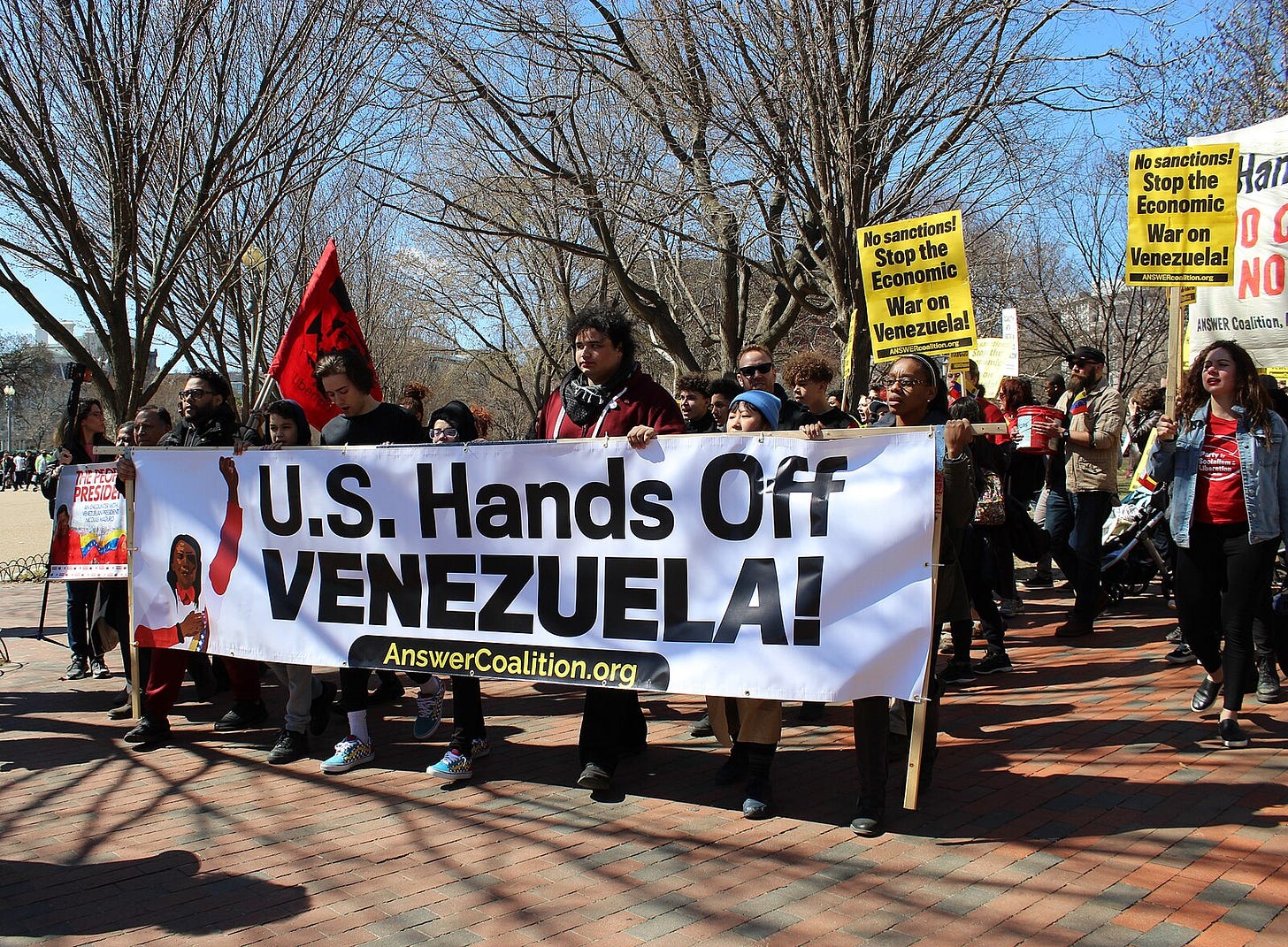Is the USA Looking for Regime Change in Venezuela?
Is Trump's force really against drug gangs, or is regime change the real goal?
Tensions in South America are at their highest level in years, as the USA’s “counternarcotics mission” has already led to an attack that killed 11 people, and now a reported violation of Venezuelan territory. The Venezuelan government has claimed that the US Navy boarded a fishing trawler in their territorial waters on Friday, 12 September. There are fears the US mission is morphing into something far more familiar to students of history; regime change by another name.
Now the White House is openly weighing whether to carry the fight directly into Venezuelan territory. According to U.S. officials, Trump has considered ordering airstrikes on cartel camps and supply lines inside the country’s borders, a move that would mark the first acknowledged U.S. military action on Venezuelan soil in decades.
For Caracas, the prospect of U.S. warplanes striking targets within Venezuela confirms their darkest suspicions. Maduro has denounced the plans as a thinly veiled attempt at regime change, while state media has amplified images of Venezuelan jets buzzing U.S. warships as proof of defiance. The possibility of American strikes on Venezuelan soil has transformed a simmering standoff into a crisis with far more explosive potential, one that could spiral beyond the pretext of drug interdiction.
Donald Trump framed the attack on the boat in international water as proof of his regime’s zero-tolerance approach to drug traffickers, releasing footage of the strike like a campaign ad. But for Venezuelan President Nicolás Maduro, it was confirmation of what he has long warned: that the United States is preparing to topple his government under the pretext of fighting crime. The USA have still not published proof that the boat was a drug vessel, however, and even if it did turn out to be a drug vessel, the attack by the US Navy would be illegal.
Is Trump About to Start a War on the American Continent?
Update: The standoff in the Caribbean turned deadly this week when a U.S. Navy destroyer struck a small vessel in international waters, killing eleven people. Washington insists the boat was tied to the Venezuelan gang Tren de Aragua, newly branded a foreign terrorist organization, and framed the attack as part of its counternarcotics mission. Trump him…
The Venezuelan state immediately condemned the strike as piracy, using it to bolster its long-standing narrative that Washington seeks to destabilize the country and impose foreign rule.
This isn’t the first time the U.S. has leveraged naval power to assert influence in Latin America. The very term gunboat diplomacy traces back to the 19th and early 20th centuries, when U.S. warships anchored off Caribbean and Central American coasts to coerce governments without firing a shot.
The Venezuelan crisis of 1902–1903, when European powers blockaded Caracas over debts and Theodore Roosevelt responded with overwhelming naval pressure, set the tone for decades of U.S. interventions justified as international policing. The Roosevelt Corollary to the Monroe Doctrine cemented the idea that Washington could act as an international police power in the Americas, justifying interventions in Haiti, Nicaragua, the Dominican Republic, and Mexico. U.S. marines patrolled the hemisphere and left deep scars in national memory, scars that still color perceptions of Washington’s actions today.
In Venezuela, those memories are amplified by the more recent history of sanctions, failed attempts to support opposition uprisings, and overt calls for Maduro’s removal from office by U.S. officials. Today’s naval buildup off Venezuela, featuring guided-missile destroyers, submarines, and surveillance planes, looks less like counternarcotics enforcement and more like history repeating itself in modern dress.
Labeling Latin American groups as terrorists expands the Pentagon’s authority while boxing Washington into escalation. Once adversaries are called terrorists, any hesitation appears as weakness, something Trump is politically unwilling to risk. By designating Maduro himself as a narco-terrorist and placing a multimillion-dollar bounty on his head, the U.S. has blurred the line between fighting crime and seeking regime change. This was the same strategy used against Panama’s Manuel Noriega in the 1980s, when Washington justified invasion by linking narcotics trafficking to political leadership. Inside Venezuela, Maduro has seized the moment, rallying militias and framing the U.S. buildup as proof of imperial aggression. Millions of civilians drilled with rifles in state-run exercises are less a serious military defense than a political show of unity against an external enemy. The longer U.S. ships remain off the coast, the easier it becomes for Maduro to claim legitimacy at home by pointing to foreign threats.
International law offers little ambiguity. Article 2(4) of the UN Charter prohibits the use of force against another state’s territorial integrity, and within the Organization of American States, collective not unilateral action is the rule. By sending warships without regional consent, Washington risks isolating itself diplomatically while inflaming anti-U.S. sentiment across Latin America.
US Warships Head To Venezuela as Maduro Mobilizes Militias and Bans Drone Flights
The standoff between the United States and Venezuela is entering a dangerous new phase. Three U.S. guided-missile destroyers are now stationed near Venezuelan waters, a move Washington claims is part of its fight against Latin American drug cartels. At the same time, the
The American continent has not seen a major interstate war in generations. Yet today, with warships circling Venezuela, militias mobilized inland, covert strike planning rumored in Mexico, and regional leaders scrambling to contain the fallout, Washington may be edging toward repeating the mistakes of its past. Trump frames it as counternarcotics, but the echoes of Panama, Grenada, and the long series of Central American interventions are unmistakable.
To many across Latin America, this is not a fight against traffickers but the return of the old imperial playbook, an updated chapter in the century of gunboat diplomacy. The longer the standoff continues, the greater the chance that a single misstep transforms rhetoric into reality, leaving the continent once again trapped in a cycle of intervention, resistance, and bloodshed.





